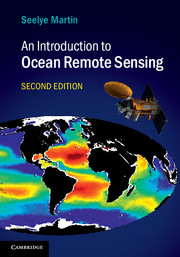Book contents
- Frontmatter
- Contents
- Preface
- List of chemical symbols
- List of mathematical symbols
- List of abbreviations and acronyms
- 1 Background
- 2 Ocean surface phenomena
- 3 Electromagnetic radiation
- 4 Atmospheric properties and radiative transfer
- 5 Reflection, transmission and absorption at the atmosphere/ocean interface
- 6 Ocean color
- 7 Infrared observations of sea surface temperature (SST)
- 8 Introduction to microwave imagers
- 9 Passive microwave observations of the atmosphere and ocean surface
- 10 Introduction to radars
- 11 Scatterometers
- 12 The altimeter
- 13 Imaging radars
- 14 Other instruments: the gravity missions, ICESat-1 and -2, CryoSat-2, SMOS and Aquarius/SAC-D
- Appendix
- References
- Index
- Plate Section
4 - Atmospheric properties and radiative transfer
Published online by Cambridge University Press: 05 June 2014
- Frontmatter
- Contents
- Preface
- List of chemical symbols
- List of mathematical symbols
- List of abbreviations and acronyms
- 1 Background
- 2 Ocean surface phenomena
- 3 Electromagnetic radiation
- 4 Atmospheric properties and radiative transfer
- 5 Reflection, transmission and absorption at the atmosphere/ocean interface
- 6 Ocean color
- 7 Infrared observations of sea surface temperature (SST)
- 8 Introduction to microwave imagers
- 9 Passive microwave observations of the atmosphere and ocean surface
- 10 Introduction to radars
- 11 Scatterometers
- 12 The altimeter
- 13 Imaging radars
- 14 Other instruments: the gravity missions, ICESat-1 and -2, CryoSat-2, SMOS and Aquarius/SAC-D
- Appendix
- References
- Index
- Plate Section
Summary
Introduction
The atmosphere lies between the ocean surface and the satellite sensor, and greatly affects the transmission of radiation. The presence of fixed concentrations of atmospheric gases such as oxygen, carbon dioxide, ozone and nitrogen dioxide, plus the variable concentrations of water vapor, means that only a few windows exist in the visible, infrared and microwave for Earth observations. Even within these windows, the atmospheric absorption varies with the concentration of water vapor and with the liquid water droplets and ice particles that make up clouds. The absorption is also affected by atmospheric aerosols, which include the water droplets and salt nuclei in the marine boundary layer, and the particulate matter generated over land by urban pollution, biomass burning and volcanic eruptions that is advected over the oceans.
In the following, Section 4.2 describes the vertical structure of the atmosphere and the molecular and aerosol constituents that affect the transmission of radiation. Sections 4.3 and 4.4 describe the propagation, absorption and scattering of a narrow beam of radiation. For the different atmospheric constituents, Section 4.5 discusses the dependence of transmissivity on wavelength and the role of these constituents in defining the atmospheric windows. To prevent the chapter from becoming overly long, the discussion is restricted to the visible/infrared; Chapter 9 extends it to the microwave. Section 4.6 applies these results to the ideal instrument. Section 4.7 discusses the radiative transfer equation (RTE) and the atmospheric emission and scattering source terms. Section 4.8 derives two limiting solutions of the RTE, one for the infrared and microwave windows where absorption and emission dominate; the other for the visible wavelengths where absorption and scattering dominate. Section 4.9 concludes with a discussion of diffuse attenuation and skylight.
Information
- Type
- Chapter
- Information
- An Introduction to Ocean Remote Sensing , pp. 79 - 112Publisher: Cambridge University PressPrint publication year: 2014
